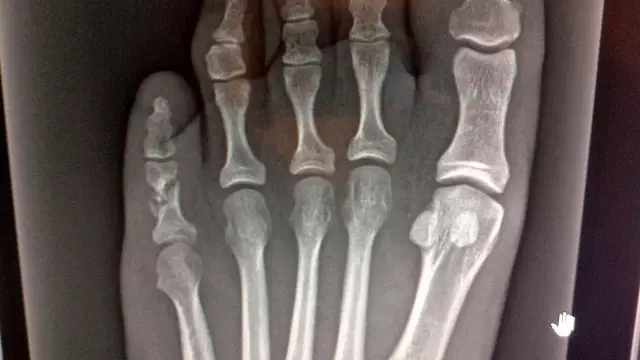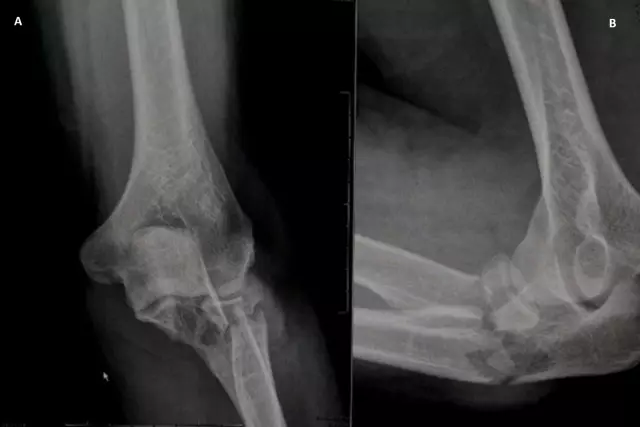- Author Rachel Wainwright [email protected].
- Public 2023-12-15 07:39.
- Last modified 2025-11-02 20:14.
How to distinguish a bruised little toe from a fracture: signs, treatment
The content of the article:
- The easiest way, as recommended by doctors
- How to tell a fracture from a bruise
- Fracture symptoms
- Diagnostics
-
First aid
- Pain medications
- Cold exposure
- General recommendations
- Treatment
- How long does it take to heal a bruise or fusion of the little finger
- Video
How to distinguish a bruised little toe from a fracture? A fracture is a violation of the integrity of the skeletal bone under the influence of force, while a contusion is a closed injury to tissues without disrupting their structure.
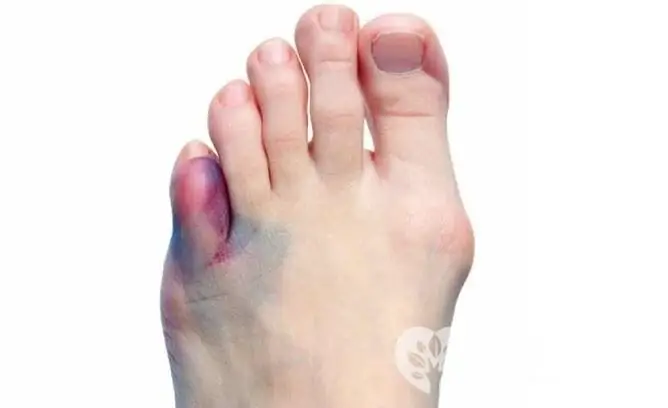
In uncomplicated cases, a bruise can be distinguished from a fracture by the characteristic features of these injuries.
Very often, a fracture of the little finger without displacement proceeds without pronounced symptoms, so the patient ignores the pain and does not pay sufficient attention to the injury. The consequence of this attitude can be bone deformation, improper fusion, osteomyelitis, or the appearance of a pseudarthrosis.
The easiest way, as recommended by doctors
On the advice of doctors, the most common and at the same time frequently used method is tapping. With the correct conduct of such a test, in most cases it is possible to distinguish a severe contusion of the little finger from a closed fracture. To do this, you need to tap on the top of your finger towards its base.
If the finger is broken, then pain will be clearly defined in the place where the bone is deformed. In the event that the bone is not damaged, then with axial tapping, pain at the site of the injury will not be felt.
How to tell a fracture from a bruise
Differences in the main symptoms:
| Symptom | Fracture | Injury |
| Pain | If the bones are damaged, the patient experiences maximum pain at the moment of injury, when the bone itself is damaged. Later, due to the development of bleeding, edema and inflammation, the pain becomes aching, dull, can spread to the entire foot, but practically does not disappear. Painful sensations persist for a long time | With a bruised finger, the pain is initially strong enough, then it subsides and after a few hours (after the swelling of the soft tissues develops) it returns, becomes aching. Painful sensations increase slightly when walking. Within a few days the pain subsides |
| Damage color | As a result of vascular damage with a fracture of the little finger, in most cases, the finger acquires a bluish tint and swells. The hematoma persists for a long period |
With minor trauma, skin reddening can occur, while serious injuries can cause the toe to turn purple and in some cases even pull off the nail |
| Finger mobility | With fractures, finger movements are limited for an extended period. The position of the little finger, when the muscles are in a relaxed state, may not coincide with its forced position. Often the patient tries to keep the finger uncomfortable in order to relieve pain. | Finger movement is limited due to severe pain and swelling. In case of bruises, as soon as the pain sensations pass, and the swelling decreases, the person begins to exercise finger movements |
Fracture symptoms
Fracture symptoms are classified according to the degree of reliability. Probable signs of bone damage in both the arm and leg include:
- pain in the area of damage (with a fracture of the little finger, it remains bearable);
- redness of the skin and soft tissue swelling;
- forced position of the little finger;
- local hyperthermia (increased body temperature in the area of injury);
- decrease or disappearance of finger movements;
- the appearance of acute pain when tapping on the end of the finger.
There are also credible signs that the injury has resulted in damage to the bones of the little finger:
- pathological mobility of the little finger;
- shortening of the injured finger;
- obvious deformation of the bone, which is determined visually even in the photo;
- a bone defect that is detected by palpation.
Diagnostics
The most important in the diagnosis of this type of fracture is the X-ray of the foot. Radiography is performed in one or two projections. It is possible to reveal a violation of the integrity of the bone in the image in 95-99% of cases. X-ray makes it possible not only to identify a fracture, but also to determine the position of bone fragments, which in the future allows you to choose the tactics of treatment.
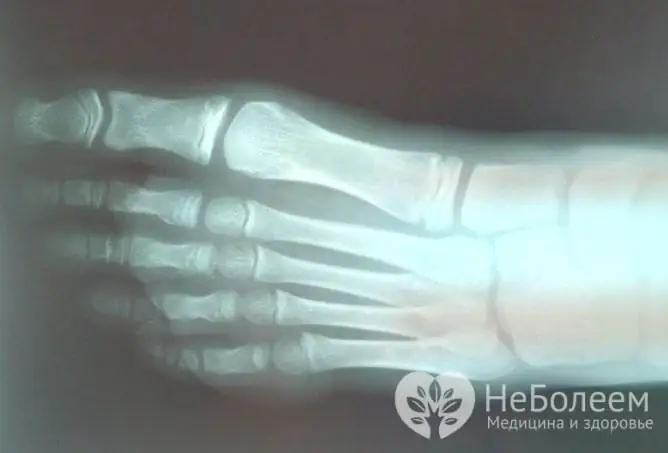
An X-ray of the foot is usually sufficient to confirm the diagnosis.
If the bones or soft tissues of the little finger are damaged, methods such as computed tomography are not used in practice, since all the necessary data can be obtained using an X-ray. Moreover, the cost of the procedures is significantly different.
First aid
Whether the bones are damaged or the little finger is bruised, the patient needs to know what to do and how to provide timely and effective assistance at home. First of all, you need to perform anesthesia, this will reduce pain and make it possible to carry out other manipulations.
Pain medications
For these purposes, use any pain relieving drugs that can be found in the medicine cabinet (Analgin, Ibuprofen, Diclofenac, Nimesil). They are taken in the standard dose indicated in the instructions. Almost any drug in this group should not be taken on an empty stomach.
Do not expect an immediate effect from taking the medication. In most cases, the pain will begin to diminish in 20-30 minutes.
Cold exposure
A good effect on both bruising and damage to the bones of the little finger is observed with the use of cold. It inactivates nerve receptors for a short period and slows down the transmission of pain impulses to the brain, thereby reducing pain. In addition, this procedure reduces the formation of hematoma and edema.
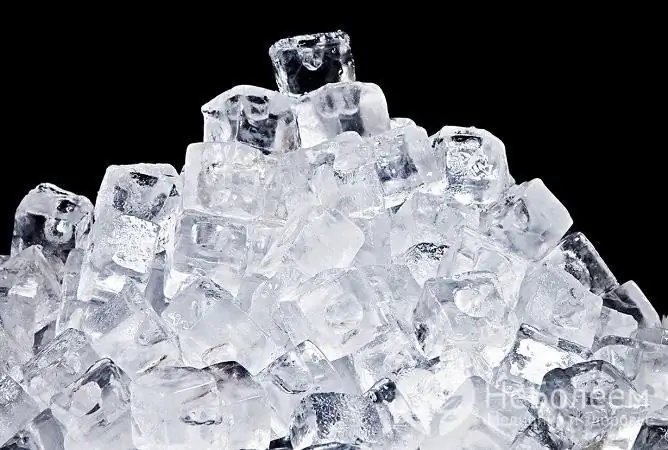
To relieve pain, ice should be applied to the injury site
The best option is to apply a crushed ice bag, as it takes the shape of a finger and provides the most intimate contact with the skin.
In order to avoid frostbite of the injured finger, the bag is removed every 5-10 minutes, and reapplied after 2-3 minutes.
General recommendations
A person should move with an emphasis on the heel so that the finger does not come into contact with hard surfaces, which will make it possible to reduce pain. Ideally, the patient should be seated or positioned so that the leg is slightly raised. This will improve the flow of blood from the injury site, resulting in a slight reduction in pain and swelling.

It is recommended to give the leg a slightly elevated position
In case of severe bruising and suspected bone damage, you should immediately seek the advice of a traumatologist. If the integrity of the bone is compromised, and there is a suspicion of displacement of bone fragments, immobilization will be performed.
Treatment
In order to reduce pain, creams or gels based on diclofenac, ketorolac, nimesulide or indomethacin are used. They are applied to the damaged area 2-3 times a day, according to the instructions.

For treatment, external agents are used, for example, Heparin ointment
To reduce swelling and get rid of hematoma, you can use drugs based on heparin, troxerutin or horse chestnut. They improve blood circulation in the damaged area, restore capillaries and reduce pain.
How long does it take to heal a bruise or fusion of the little finger
The recovery period depends on the severity of the injury. With light bruises, symptoms disappear in 4-7 days. Severe soft tissue injuries or bone fractures are treated for 2-3 weeks.
The rate of tissue regeneration depends on the age of the patient. Children and adolescents heal faster than older people. From the age of 40, the rate of regeneration decreases significantly with each passing year.
Video
We offer for viewing a video on the topic of the article.

Anna Kozlova Medical journalist About the author
Education: Rostov State Medical University, specialty "General Medicine".
Found a mistake in the text? Select it and press Ctrl + Enter.



